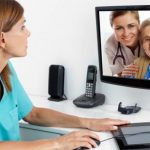 Telehealth is something I’ve touched on a number of times in the past few years, and indeed studies have suggested a number of benefits, both in terms of financial and health outcomes.
Telehealth is something I’ve touched on a number of times in the past few years, and indeed studies have suggested a number of benefits, both in terms of financial and health outcomes.
As with many technologies however, there is a risk that the hype cycle runs wild and we start treating telehealth as a silver bullet that will save all of our healthcare woes, especially given the considerable resource constraints faced by many health systems around the world.
No silver bullet
Alas, whilst this is indeed true for some patients, a recent study published in the British Medical Journal revealed that telehealth is not the answer for everyone.
Now, first of all, the inevitable caveat that always accompanies academic research. This particular study was looking specifically at the Healthlines Service, which is a telephone based service whereby patients receive calls from a health advisor. So that’s a big caveat that I will return to later.
Several hundred adults at risk of heart disease or stroke were signed up to receive advice via the service, whilst half received care in a more traditional way. The researchers were looking for any changes in things such as blood pressure, BMI or cholesterol.
“We found some evidence that the Healthlines Service led to modest improvement in overall cardiovascular risk for a minority of participants, but had no impact on average risk. But the Service did have other benefits, such as improvements in diet and physical activity, and patients were more satisfied with their access to care and the treatment they received,” the researchers say.
The Heathlines Service was further put through its paces in a second study, this time published in Lancet Psychiatry, that looked at its impact on patients with depression. In this instance, small improvements were seen in areas such as depression and anxiety, with patients also happier with the support they were receiving.
“The results of our studies show that while a telehealth intervention such as this can be beneficial to some patients, it is not the magic bullet that some policy-makers seem to think it is. However, it is a relatively low-cost intervention that can make health care more accessible for conditions that affect a large number of patients, so there is good reason to continue exploring ways to make telehealth more effective in future,” the authors conclude.
Not all telehealth is made the same
Now, it should be said that telehealth as delivered via telephone is not something I’ve touched on a great deal, with most modern solutions utilizing video technology in some way shape or form. This in itself represents a problem, as a broadbrush application of telehealth makes it very hard to accurately gage its usefulness, and very easy to make generalizations about its viability.
There is also a risk that we regard telehealth as a way to do exactly what usually takes place in face-to-face consultations, via telephone or a Skype like interface. Whilst this is tempting, it’s something that should be avoided, as the best telehealth platforms allow us to do so much more.
This might include something relatively simple such as recording consultations so that we, or our loved ones, can view them again. It might include offering a more intuitive triage system, such as unveiled by Babylon recently, to make visits to a doctor more informed (and hopefully infrequent). It might include plugging in a multitude of wearable devices or deploying artificial intelligence to make sense of this data.
As such, it’s rare that one telehealth service will be similar to any other, but hopefully as the industry matures, we will gain a greater understanding of just what it is capable of.